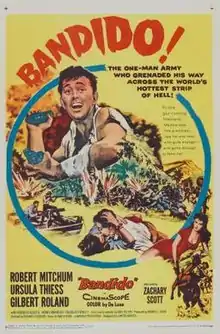Bandido (1956 film)
Bandido is a 1956 American Western film starring Robert Mitchum. The supporting cast includes Ursula Thiess, Gilbert Roland, and Zachary Scott. The film, set in the Mexican Revolution and filmed on location around Acapulco, was written by Earl Felton and directed by Richard Fleischer. Robert Mitchum also co-produced the film through his DRM Productions company.[2]
| Bandido | |
|---|---|
 | |
| Directed by | Richard Fleischer |
| Produced by | Robert L. Jacks |
| Written by | Earl Felton |
| Starring | Robert Mitchum Ursula Thiess Gilbert Roland Zachary Scott |
| Music by | Max Steiner |
| Cinematography | Ernest Laszlo |
| Edited by | Robert Golden |
Production company | D.R.M. Productions |
| Distributed by | United Artists |
Release date |
|
Running time | 92 minutes |
| Country | United States |
| Language | English |
| Box office | $1.65 million (US)[1] |
Plot
In the 1916 Mexican Revolution, American mercenary Wilson (Robert Mitchum) checks into a hotel in Northern Mexico during a battle. Equipped with a suitcase full of Mk 2 grenades, he throws a few "samples" at the Federal troops in the square, turning the tide of the battle. Revolutionary Col. Escobar (Gilbert Roland) and his men praise Wilson's efforts, calling him "El Alacran" (the scorpion) for the sting of his grenades. Col. Escobar is still a bit wary about why an American would want to help them. Wilson explains a plot by an American gun runner, Kennedy (Zachary Scott), to sell a large shipment of arms and explosives to Federal forces, but he's not sure where they are.
Encouraged by Wilson to capture Kennedy, they attack his train and stop it. Kennedy lies, saying the arms are at his fishing lodge. Wilson makes time with Kennedy's flirtatious wife, Lisa (Ursula Thiess). After the capture of Kennedy, Wilson goes to the lodge to find Lisa, whom he saves from Escobar's firing squad and encourages to flee north to the U.S.
Angered by what he perceives as treachery, Gen. Escobar imprisons Wilson along with Kennedy, who is in an old mission awaiting the firing squad. Wilson, inexplicably, still has two hand grenades, which he uses to blow their way out of the mission. With Escobar chasing them through the jungle and over a waterfall, they both escape, but Kennedy is shot and later dies.
Knowing the arms location, which the dying Kennedy has given him, Wilson and Escobar ride to the coast and Kennedy's fishing villa. The arms were to be delivered by barge in a day or two. They encounter federal troops about to ambush Escobar's rebel force. Wilson then offers Escobar a "compromise" by getting a M1917 Browning machine gun out of the arms barge and offering to blow up the explosives barge. The barge is cut free of its moorings to drift towards the troops on shore. A few rounds into this barge by Wilson and the Federals are blown up.
After his men then load up the arms, Escobar releases Wilson, saying, "Adios, El Alacran!" Wilson heads north to rejoin Lisa.
Cast
- Robert Mitchum as Wilson
- Ursula Thiess as Lisa Kennedy
- Gilbert Roland as Colonel Escobar
- Zachary Scott as Kennedy
- Rodolfo Acosta as Sebastian
- José Torvay as Gonzales
- Henry Brandon as Gunther
- Douglas Fowley as McGhee
Production
The film was based on an original screen story by Earl Fenton called Horse Opera. It was about an American movie company in the early 1900s who is captured by Pancho Villa. The hero was a soldier of fortune, the right hand man to Pancho Villa, who falls for the movie company's leading lady, rescues her from Villa, takes her to Hollywood and becomes a movie star. A producer, Robert L Jacks liked it and set up the film at United Artists, with Robert Mitchum to star and Richard Fleischer to direct. Fleischer had worked with Fenton several times but says the screenwriter wrote a script which diverted significantly from the original treatment, removing the movie company, the leading lady, Hollywood and Pancho Villa. Fleischer wanted to pull out of the project but United Artists were worried they would lose Mitchum and threatened to sue.[3]
This film was shot on location in Mexico at Cuernavaca, Tepetlán, Palo Balero in Xochitepec, Yautepec de Zaragoza, Acapulco, Iguala and the Hotel Hacienda in Cocoyoc, Morelos.[4]
Reception
Fleischer wrote that the film "turned out to be quite a good, commercially successful picture. It has, however, absolutely nothing to do with the picture I started out to make."[5]
References
- 'The Top Box-Office Hits of 1956', Variety Weekly, January 2, 1957
- http://www.tcm.com/tcmdb/title/17031/Bandido/notes.html
- Fleischer, Richard (1993). Just Tell Me When to Cry: A Memoir. Carroll and Graf. pp. 129–130.
- http://www.tcm.com/tcmdb/title/17031/Bandido/notes.html
- Fleischer, Richard (1993). Just Tell Me When to Cry: A Memoir. Carroll and Graf. p. 140.
External links
- Bandido at IMDb
- Bandido at the TCM Movie Database